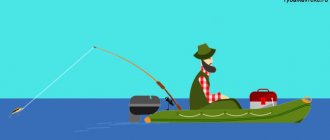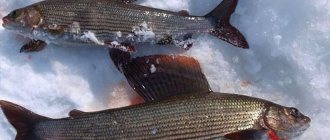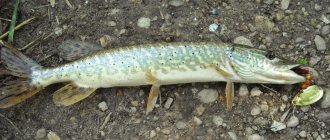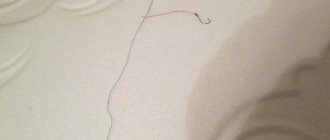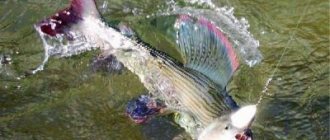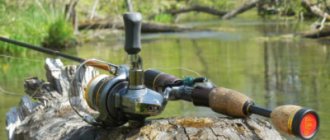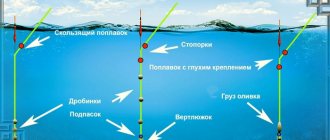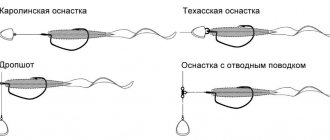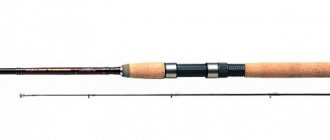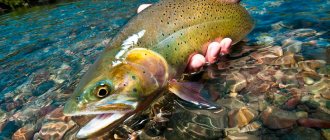Ultralight fishing technique
Only a few years have passed since ultralight fishing became known, and today we are witnessing a real boom.
The prestigious “fashion” for ultra-light spinning rods has especially intensified over the past 2–3 years. What are the reasons? First. In the central zone of the Russian Federation, the overwhelming number of reservoirs have been subjected to fishing pressure. Instead of catching a catch, returning “empty-handed”, that is, with nothing - you agree, is far from a fisherman’s most cherished dream (let’s not be deceived and say that fish is not the main thing). Helping to use micro-bait and having a light rod, ultralight eliminates the “zero result”, which arouses genuine interest, mixed with delight.
Second. The ultralight fishing technique owes its popularity largely to athletes. Their passion in pursuit of the catch did its job: the fishermen recognized the unconditional validity of super-light tackle.
Third. About five years ago, manufacturers flooded the market with microbaits and a number of other means for “jewelry” fishing. Against this background, the choice of ultralight spinning rod has become a significant priority - both in terms of the ability to fight hooked fish and in terms of the sensitivity of the bait by the fisherman.
Ultralight fishing
What can I say! You need to try for yourself what an ultralight spinning rod is and experience all the nuances personally. Realize how high-yield fishing it provides. Get ready for the fact that you may be hooked into something serious. In this case, fishing with ultralight equalizes the chances of both sides - the angler and the fish. The fight can take a serious turn! Here you need to think: will it be possible to maintain the integrity of the rod, and will the fishing line break during the struggle? If you are ready to win, then go forward, friends. After all, the cost of ultralights is quite steep.
Believe me, sometimes the result is no less than from a conventional spinning rod, feeder or float rod (and there are often cases when a much larger trophy is caught). If you want all this to become a reality in your life, you just need to learn fishing techniques, master the gear, and acquire confident skills.
Video: pike on ultralight
This video shows fishing with an ultralight spinning rod on a picturesque small river. You will see an interesting process of fishing, catching and landing pikes.
Views: 232
Similar articles:
- Spinning rod for pike: test, action, length, choice of budget model. Top 5 rods To successfully catch pike using various artificial baits, an angler will need…
- Shimano spinning rods The excitement of hooking and fishing, the exciting fight with a toothy predator –…
- Fishing for pike in summer using a spinning rod The most suitable time for fishing for pike is spring and…
- Casting spinning rod: difference from a regular one, features, how to choose The equipment of a modern fisherman is no longer limited to a simple fishing rod with fishing line,…
Ultralight spinning rods
There is still no unambiguous definition of which spinning rod to choose for ultralight - more precisely, within what limits the rod test lies. According to some, the upper test allows up to 10 and even 12 g. Others zealously defend a gradation of 5–6 g (upper test) and nothing more. Which “ideological camp” you personally ultimately belong to is up to you to decide. Much will depend on your personal experience and feelings. Let's give this example: the current is strong, and the weight of the wobbler is only 2-3 g. A spinning rod with a dough above 10 g will most likely simply bend and stop working.
Relatively recently, manufacturers found this solution: to divide ultralight rods into 2 categories:
- those whose test ranges from tenths to 5-6 grams are super light;
- the upper limit of the test is up to 10–12 g - more powerful.
Example. Rod "G. Loomis STR-1141S" tests in the 1.8-10.6 g category (range 1/16 to 3/8 oz). Nevertheless, it clearly refers to ultralights.
It is important to note that ultralight spinning rods are subject to incredibly strict “selection” according to evaluation criteria. To bear their proud name, they must have the following characteristics:
- impeccable quality of fittings (and form);
- high sensitivity;
- possibility of a good throw;
- flawless assembly.
Are such high demands a whim? No. More like a necessity. After all, we are talking about miniature baits with fairly frequent bites from small individuals (weighing up to 1.5–2.1 kg). Therefore, the slightest omission, the slightest imperfection - and you are guaranteed to break the rod while fighting large fish. In other words, safety margin is a fundamental requirement even with the most elegant looking rod.
Now regarding the power and length of the rod. Here, too, there is still no consensus. When you open any catalog, you will find among ultralights both long (over 2.5–2.7 m) and short (up to one and a half meters). Although your task in fact is not to delve into the intricacies of the producers’ thinking, but to put your own specifics at the forefront - the specifics of a particular body of water, objective fishing conditions. And based on this, decide on the length.
It is not difficult to understand that a rod longer than 2.1 meters will not work on streams, on small rivers, and especially in the presence of coastal vegetation. You will have to get into the water to cast from the side or from below. Agree, it’s much more dexterous to use a rod of 1.5–1.8 meters in length.
Let us note a trend that has emerged recently - some fishermen began to actively experiment with spinning rods up to 3 m in length. This can partly be explained by the fact that many fishermen have successfully mastered ultralight fishing in shallow bays and large rivers (although it is most typical of the southern regions).
And yet, speaking of a certain golden mean, it makes sense to try fishing on a rod with a length of 1.8 to 2.0 meters. It will not fail on a big river or stream. Of course, the emphasis is on the reliability of manufacturers (i.e., the prestige and “trust” of the company). Their products, as a rule, guarantee excellent casting.
It is worth mentioning the medium-fast action rods - their ability to cast well and very high sensitivity are invaluable qualities for the angler. An excellent ultralight spinning rod for microjigging, as well as for fishing with spoons and wobblers. And they hold the fish perfectly - any attempts to break are extinguished. Rods with slower casting are no worse, but they are completely unsuitable for microjigging, and casting accuracy is noticeably less.
Jig rods are recognized as the fastest rods. Their indisputable advantages include high sensitivity. But here’s the problem with range: ultralight baits weighing 2–3 g do not give you a chance to make a high-quality long-distance cast. You probably have an objection: “but casting range for an ultralight is not an end in itself.” That’s how it is, but you must admit that the ability to throw a 2-gram bait at 25–30 meters can hardly be considered overkill, can it?
And now about the painful part. Price issue. It is unlikely that any fishermen have their head in the clouds, naively classifying ultralight rods as cheap - this tool must meet too many requirements. The minimum price level is approximately 5,000 rubles, and from there it goes higher and higher. If you really want to save money, you, of course, have the right to buy an ultralight spinning rod at a price of 3–5 thousand rubles, but such a purchase is guaranteed to meet only some important indicators (such as: the casting is good, but there is no sensitivity, and so on).
Reel for ultralight
An important point is which reel to choose for ultralight without sacrificing proper balancing. Naturally, only the lightest versions are suitable. True, in addition to lightness, the requirements here are no less demanding than for fishing rods (as we discussed above). And these requirements concern two extremely important points:
- clutch reliability;
- line winding quality.
As for the reel sizes, feel free to use within 1000 (optimally - Shimano classification).
Ultralight line
The question is often asked: how will a braided fishing line for ultralight behave with any bait up to 5 grams in weight? The answer is clear: no, it is not recommended. Let's start with the fact that it is almost impossible to find ultra-thin lines, and if you do find them, then with their enormous strength you cannot avoid exceeding the rod's performance recommended by the manufacturer.
We will assume that any cords in clear water are quite noticeable. Whether it’s a chub or an ide, a predator can easily “calculate” the fact that it is being hunted, as a result of which the number of bites will inevitably decrease. In addition, the risk of breaking an expensive fishing rod increases.
Do you want to know which fishing line to put on an ultralight would be the optimal solution? Advice from experienced people: the highest quality, softest monofilament lines, the diameter of which is 0.12–0.14 mm. The maximum you can deviate from these limits is a thickness of 0.16–0.18 mm, but this is only for baits weighing over 10 g. And even then only when fishing in reservoirs with a heavily overgrown bottom.
Rotating spoons for ultralight
Micro spinners are the leader among baits, especially if ultralight fishing is carried out using spinners up to No. 1. There is probably not a single leading manufacturer who does not produce such baits today. The main advantage of turntables is that their use is possible and accessible under almost any conditions. For example, good flightability is important in any wiring. By the way, this is one of the reasons why the French “Mepps No. 0” and “Mepps No. 00” are so popular today.
Sometimes questions arise about color. Nobody will give you universal advice, because according to most experts, white with red spots or pure white is the most universal petal color. But black microfingers are no less successful in some cases (although they do not imitate fry, in the eyes of a predator they look like something feeding in motion - and therefore subject to attack and capture).
Fishing from the shore on small rivers
Uniform distribution

The fisherman needs to cast the equipment directly against the current - 3-7 meters - and then reel in the line at low speed. It is advisable to sometimes use jerks and take short pauses.
Wiring for demolition
Used when fishing in water areas with particularly sharp currents. You will need to cast the rig perpendicular to the stream or slightly lower, at an angle of 45 degrees, after this maneuver you should allow the stream to carry the bait without reeling in the line and keeping the top of the spinning rod raised. With this technique, your rig will play due to the current acting on it.
Wiring under trees and fairly large bushes
The rig should be raised to a certain point, at which it is impossible to cast because of the branches, and then slowly reel in the line. You need to throw the rig a little higher than bushes and trees, or an object in the water, let the bait float a little, and then start reeling in the fishing line.
Fishing with bright rigs using a boat
The boat provides enormous opportunities for the fisherman, which allows fishing in any direction. Three points stand out when fishing from a boat:
Wiring perpendicular to the flow
Try to throw the rig as close as possible to the point where the chub is supposed to be standing, for example, under trees, or large bushes, after a stream in the current, and so on.

When fishing for chub along the grass, you should throw the bait downstream, and then run the line parallel to the vegetation. Try all possible options.
Roach spawning
Catchable wobblers for chub >>
Wobblers for ultralight
Since we are talking about fishing on small rivers, the optimal solution would be microwobblers for ultralight with a depth of 1.0–1.5 meters (no more). With a bait weight of 2–3 g, their size should not exceed two to three centimeters.
As for buoyancy, suspenders and floating ones are appropriate, and sinking wobblers are also appropriate. It is only important that the blade is small. In general, sinking ones have an advantage - you can make a longer cast, which becomes especially effective in a stream (the wobbler lingers at a certain depth, without ceasing to “play” even during a pause).
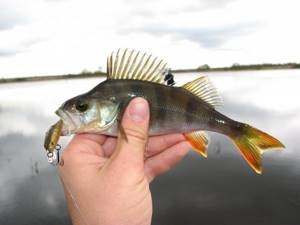
Ultralight fishing tactics
But floating bait also has its merits. They are indispensable on a catchy bottom, in places with increased grass growth (use the Sorcerer 35 STD wobbler, manufactured by Halco; Rapala is a good company - models Original and Yo Zuri).
Of course, the wiring will depend on the type of bait chosen. Many fishermen praise the Rebel company and its small wobblers, which look very much like insects. If your goal is to catch a chub, then ultralight fishing with jerk wiring will absolutely bring high results, that is, a worthy trophy. Fishing with such bait is especially effective if the place where the chub stands is known for sure. After an accurate cast, the bait begins to splash down, and this is where the bite occurs. It is advisable to use the same technique in fly fishing.
Let us note (as a separate class of ultralight baits) various variants of jigs. More precisely, the subject of conversation is microjig. This is a very specific area. One might say, an independent direction of ultralight. Its subtleties should be studied separately, more specifically and in depth.
Autumn fishing for chub
Fish are simply ideally caught using ultra-light rigs on fairly small bodies of water. This type of fishing has many advantages. All the sights, for example riffles, holes and pools, places where there are a huge number of fallen trees and large bushes, the boundaries of running and standing water, can be easily noticed even by a not particularly experienced fisherman. In addition, in any of these places there is an opportunity to get a good catch.

When fishing in harsh conditions (flooded trees, huge bushes along the shore), while using a swimming device, it is recommended to use ultralight spinning tackle up to 2.4 meters. When you need to cast over a huge distance and nothing prevents you from spinning, you can use a stick up to 2.7 meters.
